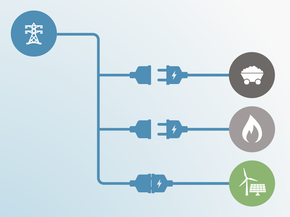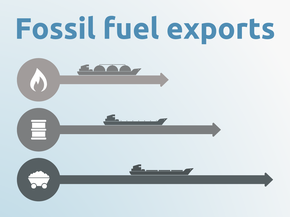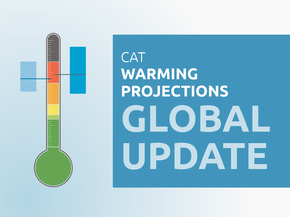Current Policy Projections
Economy-wide
Between 1990 and 2000, emissions in Ukraine dropped by 56% from 947 MtCO2e to 421 MtCO2e excl. LULUCF. From 2001 to 2007, emissions started to increase again moderately, followed by a steep decline during the financial crisis in 2009 and further declines in recent years as a result of the conflict in eastern Ukraine. Between 2015 and 2016, emissions increased by 6% to 339 MtCO2e, however, this level is still far lower than before 2014.
Currently implemented policies are expected to lead to an emissions level of 407–409 MtCO2e excl. LULUCF in 2020 and 514–546MtCO2e excl. LULUCF in 2030, i.e. Ukraine is likely to reach its NDC targets.
Since 2011, Ukraine has a carbon tax which applies to CO2 emissions from stationary sources in the industry, power and buildings sectors. In November 2018, the Ukrainian parliament decided to increase the carbon tax rate from UAH 0.41/tCO2 (0.02 USD/tCO2) to UAH 10/tCO2 (0.36 USD/tCO2) from January 2019 onwards. In the coming years the carbon tax rate will increase by UAH 5/ tCO2 (0.18 USD/tCO2) per year until reaching UAH 25/tCO2e (0.89 USD/tCO2) in 2020 (Ministry of Finance of Ukraine, 2018). Even with this increase, the rate would remain the lowest carbon price among all currently implemented carbon pricing initiatives worldwide (World Bank and Ecofys, 2018).
In July 2018, Ukraine published its 2050 Low Emission Development Strategy. This strategy provides emission reduction pathways for the energy and industry sectors based on four scenarios containing different ambition levels of decarbonisation measures and policies. If fully implemented, Ukraine could significantly overachieve its NDC target with emission levels of 20% to 44% below the 2030 target.
Energy supply
The energy supply sector is responsible for 67% of Ukraine’s total emissions excluding LULUCF. In 2008, Ukraine introduced a feed-in-scheme with fixed prices, called the "green" tariff for electricity. The green tariff also guarantees grid connectivity to all renewable power generated from the project. The feed-in tariffs (FiT) were initially established at relatively high rates: 0.42 €/kWh for rooftop solar PV under 100 kW and 0.11 €/kWh for wind projects with capacity greater than 2 MW (International Energy Agency, 2017a). The tariffs were updated in 2012, 2015 and 2017 and adjusted to market levels. The International Energy Agency (2017a) reports FiT rates of 0.16€/kWh for roof-top solar and 0.10€/kWh for large wind projects (greater than 30 kW capacity).
The amendment in 2015 removed the “local content requirement” previously introduced in 2013. This was replaced by a “local content premium,” which provides an additional premium to plants using components produced domestically. A 5% premium on top of the regular feed-in tariff is provided for 30% local content, while a 10% premium is provided for 50% local content (International Energy Agency, 2017a). In the case of a wind turbine, the blade and tower are each considered to be 30% of the plant, while the main frame and nacelle are each considered to be 20% of the plant (International Energy Agency, 2017a). In the case of a wind turbine, the blade and tower are each considered to be 30% of the plant, while the main frame and nacelle are each considered to be 20% of the plant.
In 2017, Ukraine updated its energy strategy through to 2035 (Government of Ukraine, 2017). The strategy sets new targets for electricity generation from different energy carriers. In 2035, 25% of electricity generation is foreseen to come from renewable energy sources other than hydropower (2016: 1%),1 13% from hydropower (2016: 6%), 50% from nuclear power (2016: 49%) and the remaining 12% from thermal power plants (2016: 44%). However, a step-by-step implementation plan has not been developed yet. As there are no clear supporting policies tabled or discussed, except the feed-in tariff mechanisms, we have not further quantified the energy strategy in our analysis.
In April 2018 the national transmission system operator Ukrenergo announced—following an earlier announcement in June 2017 on full integration with the European Network of Transmission System Operators Electricity (ENTSO-E) by 2025—the support of full-scale deployment of renewables in Ukraine and investments in grid modernisation (Energypost.eu, 2018). To stimulate the development of renewable energy a draft law has been submitted to parliament in June 2018 proposing a new support scheme for renewable energy based on capacity auctions (Energypost.eu, 2018).
1 | 2016 energy mix based on IEA statistics (International Energy Agency, 2017b).
Industry
The industry sector is responsible for 17% of Ukraine’s total emissions excluding LULUCF. However, a significant part of the emissions in the energy sector are also related to industry. In January 2018 Ukraine’s environment ministry published a draft law that will require big emitters to audit their emissions as an initial step towards Ukraine developing a functioning Emission Trading System (ETS) by 2020 (Carbon Pulse, 2018). The draft law contains no information on the emissions threshold for installations, but sets out plans for a government registry, third party verification, and a process for companies to devise emissions monitoring plans. As this policy is still under development, we have not taken it into account in our analysis.
Transport
The import of electric vehicles is exempt from VAT and the excise duties until 2022 (Ministry of Finance of Ukraine, 2018).
Further analysis
Latest publications
Stay informed
Subscribe to our newsletter







